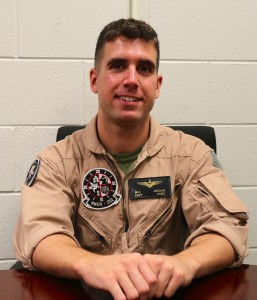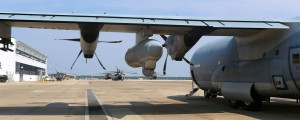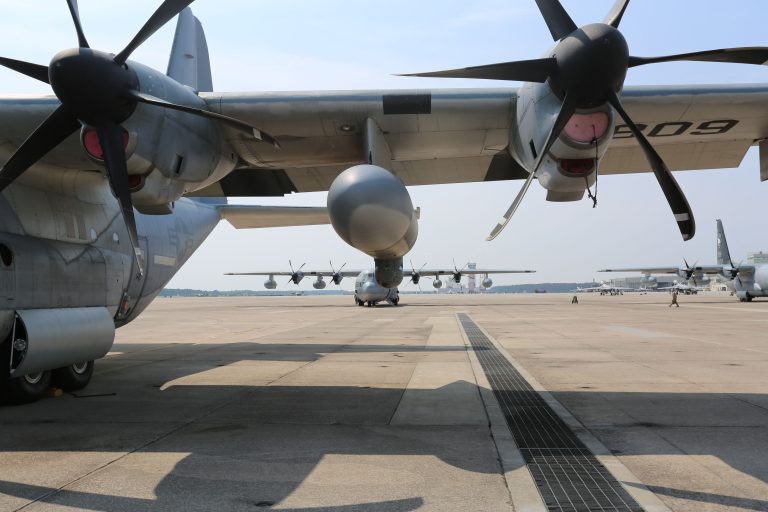The Harvest Hawk: KC-130J in Operational Evolution
During a visit to Second Marine Wing in 2014, there was a chance to discuss the Harvest Hawk configuration of the KC-130J with Marine Corps Operators.
2014-07-31 By Robbin Laird
During my latest visit to Second Marine Air Wing, I focused upon the USMC evolution of its use of the KC-130J.
I spent a morning in the KC-130J simulator watching Marine pilots hone their skills and did so from the tanker seat in the aircraft.

After the simulation experience, I sat down with one of the pilots, Captain Michael Jordan, to talk about his experience working with the Harvest Hawk in Afghanistan.
The Captain is of the new generation of USMC pilots who have flown the KC-130J from the beginning and so the Harvest Hawk experience seems a “normal” evolution and simply preparing for the next transition, whereby the “mother ship” can handle data, C2 or ordinance dependent on the evolution of USMC concepts of operations.
The Harvest Hawk was first introduced into Afghanistan by 3rd MAW so the squadron went to the West Coast to learn their skills in preparation for their use of Harvest Hawk in Afghanistan in 2012.
We trained as Harvest Hawk co-pilots right before we deployed for Afghanistan last year.
And I would say that at least half of the hours we flew in Afghanistan starting in July 2013 through February of this year were Harvest Hawk missions.
After that I went to Spain and became part of the Special Purpose MAGTF.
He emphasized as well that it was different type of flying than on other KC-130J missions.
A lot of what you are doing is working in orbits, circling around targets, talking with people on the ground and managing the battlespace. 95% of what you are doing is flying, holding your orbit and then waiting for that 5% of the mission where you prepare to and then launch your ordinance.
And in flying the plane the operation from the cockpit is different as well.
With the Heads up Display you are flying the aircraft. Now you need to not just focus on just flying the aircraft and executing the mission but also work with the navigation radar to see where you are going and what you are doing within the battlespace.”

Question: What are the trade-offs necessary to operate a KC-130J as a Harvest Hawk?
Captain Jordan:
We lose the external tank on the left side as a sensor is placed on that tank.
We can not fuel from the tank.
This means that we reduce total fuel capacity.
A typical J would have a max fuel capacity of 60,000 pounds dependent upon fuel conditions.
With the Harvest Hawk configuration we can have a max fuel capacity of around 42,000 pounds. This reduces our time on station.
The Marine Corps is looking at an upgrade which would put the sensor on the front of the plane rather than the external tank and would recover the use of the tank.
The other aspect is that we lose the left side Aerial Refueling pod.
We have four hard points on the left side for the missiles; we can do refueling but with only one hose on the right hand side.
We can not have two houses serving the tanker mission.
Question: How are operations different from inside the aircraft to operate the Harvest Hawk mission?
Captain Jordan:
It is quite different.
In Harvest Hawk the pilot becomes more of a battle manager, while the co-pilot flies the plane.
In the back of the aircraft we have a different crew as well.
We generally have two officers in the back; a Fire Controls Officer sits in the right seat and operates the sensor to provide for target acquisition.
Typically, we have an assistant in the left seat to aid with the communications traffic and to assist the FCO.
Question: Where does Harvest Hawk go next?
Captain Jordan:
The entire Harvest Hawk experience highlights the utility of a “mother ship” in an air dominance environment.
There is no reason that we cannot take data from UAVs or the F-35s or the Harrier litening pods and be able to contribute to combat management or support to the ground commanders.

